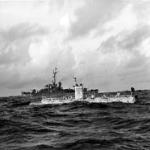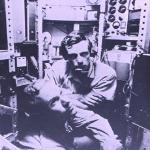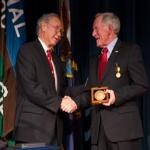21 June 2010
Donald Walsh grew up near San Francisco in the 1930s. Among his earliest memories is the mega-construction project he saw from his home in the Berkeley hills.
"Namely, the Golden Gate Bridge," he says. "And I used to watch the ships go out over the horizon. I was seven or eight years old and from that age on I really got keen at going to the sea and knowing about the ocean."
Walsh graduated from the U.S. Naval Academy in 1954. A chance assignment in 1958 led him to the Trieste.
He tested the free-diving self-propelled submersible — one of only two in existence at the time — on increasingly deep dives off the California coast. He was told of a plan to take the bathyscaphe to the deepest part of the ocean, roughly 11,500 meters or deeper than Mt. Everest is high.

US NHHC
The Trieste right before her dive to 35,800 feet in the Challenger Trench in the Pacific Ocean near Guam."That really got my attention because I knew I was going to be a part of it," says Walsh.
The Trieste is now on permanent display at the Naval Museum in Washington. The bathyscaphe is over 16 meters long, and its gasoline-filled flotation chamber's deck, rails, and conning tower make it look a bit like a submarine.
"Basically, it's an underwater balloon. You've got two parts to it: You've got the balloon here — which is this long cylindrical object — and that's filled with a lighter-than-water substance, which is aviation gasoline," Walsh explains. "Oil floats on water, and so you get the buoyancy or lift. Then, beneath the balloon you have a cabin for the fragile humans."
History-making dive
That cabin is a 14-ton spherical steel capsule only two meters in diameter, with a single, half-meter-wide circular plastic window for viewing. There is just enough room for two people. Walsh was joined on Trieste's historic dive by co-pilot Swiss scientist Jacques Piccard — whose father, Auguste Piccard, had designed the craft.

NOAA
Lt. Don Walsh (left) and Jacques Piccard (center) in cramped quarters inside Trieste's chamber on January 23, 1960.On Jan. 23, 1960, the two men took the Trieste to the deepest point in the Pacific Ocean's Mariana Trench, a ravine called Challenger Deep.
The success of that mission opened the door for deep sea exploration.
Walsh grabbed an opportunity that others would later follow. "We do see bits of our DNA all over in today's underwater vehicles, both manned and unmanned, because [of] the things that we developed. Remember, everything we did was a first, not because we were pioneers or inventors, but it is literally, necessity is the mother of invention. We needed something, we had to invent it."

Courtesy Donald Walsh
Donald Walsh in front of the Russian Mir Submersible after diving to the World War II German battleship Bismarck.Distinguised career
Over his long naval career, Walsh served in both the Korean and Vietnam wars, commanded a submarine and worked as a policy advisor and assistant to the secretary of the Navy.
When he retired from the Navy in 1975, he accepted a position at the University of Southern California where he founded and directed the Institute for Marine and Coastal Studies and was a professor of ocean engineering.
Walsh spent eight years in academia. The retired Navy captain continued to pursue his passions as a scuba diver, private pilot and explorer, participating in dozens ocean dives and expeditions to the polar regions.

Rebecca Hale/National Geographic
Don Walsh is given the Hubbard Medal by National Geographic.Still exploring
Exploration, he says, has been central to his life.
"Exploration is curiosity acted upon," Walsh says. "People can look at things and be curious about them, but if you are an explorer you want to know why and how and maybe develop an experiment to test the hypothesis." He says in his life, "It [has] always being able to look around the next corer and see what's going on."
Still vibrant at 78, Walsh lives on the Oregon coast and runs his own consulting business.
He was in Washington recently to pick up two awards — the Navy Distinguished Public Service Medal and the Hubbard Award from National Geographic, the Society's highest honor given for distinction in exploration, discovery and research.
No human has returned to the deepest part of the ocean, although remotely operated vehicles have.
Walsh applauds those advances in technology, but laments that most of the world's deep oceans remain unexplored and that only a handful of vessels — manned or unmanned — exist to do the job.